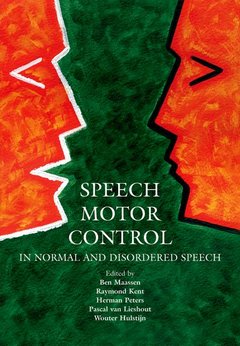Description
Speech Motor Control In Normal and Disordered Speech
In Normal and Disordered Speech
Coordinators: Maassen Ben, Kent Raymond, Peters Herman, van Lieshout Pascal, Hulstijn Wouter
Language: English
Subjects for Speech Motor Control In Normal and Disordered Speech:
Speech Motor Control in Normal and Disordered Speech
Publication date: 08-2007
476 p. · 17x25 cm · Paperback
Publication date: 08-2007
476 p. · 17x25 cm · Paperback
Speech motor control in normal and disordered speech
Publication date: 02-2004
480 p. · 17.4x24.9 cm · Hardback
Publication date: 02-2004
480 p. · 17.4x24.9 cm · Hardback
Description
/li>Contents
/li>
Speaking is one of the most complex skills that humans perform. In our everyday communication, we transfer sentences, concepts, thoughts, and ideas. How though, is the speaker able to convert these into movements of the speech apparatus? These speech movements are the observable end product, but what neurological, psycholinguistic, and perceptual-motor processes lie behind their production? To fully understand speech disorders, such as stuttering, apraxia of speech, and Parkinsonian dysarthria, the disruptions in this complex interplay are highly relevant. Equally important is the question of how the infant develops from random babbling to precisely controlled production of words, syllables, and phonemes. This volume presents state of the art research in the science of speech motor control and speech disorders. All the chapters take a fundamental, model-oriented perspective, as introduced in the first section of the volume. Further topics covered in this book are: brain imaging studies and the rapid progression in comprehending neural mechanisms; developmental studies revealing perceptual-motor continuities and discontinuities; psycholinguistic experimentation showing higher order influences on speech motor control; and recent notions and applications to the understanding of speech disorders. This will be an important volume for all those involved in speech research and speech pathology, including those from the disciplines of psychology, neurology, and ENT.
Part I - Modelling of speech production. Models of speech motor control : implications from recent developments in neurophysiological and neurobehavioural science. A neural model of spech production and its application to studies of the role of auditory feedback in speech. Dynamical systems theory and its application in speech. Part II - Neural processes. Functional brain imaging of motor aspects of speech production. Recent developments in brain imaging research in stuttering. Subcortical brain mechanisms in speech motor control. Part III - Speech motor development. How do infants come to control the organs of speech. Physiologic development of speech production. Sensorimotor entrainment of respiratory and orofacial systems in humans. Part IV - Interface. Interaction of motor and language factors in the development of speech production. Linguistic processes and childhood stuttering. Part V - Motor control in disorders. Motor control perspectives on motor speech disorders. Searching for the weak link in the speech production chain of people who stutter : a motor skill approach. Stuttering and internal models for sensorimotor control : a theoretical perspective to generate testable hypotheses. The differential diagnosis of apraxia of speech. The role of the syllable in disorders of spoken language production.
© 2024 LAVOISIER S.A.S.
These books may interest you

The Handbook of Speech Production 203.75 €



